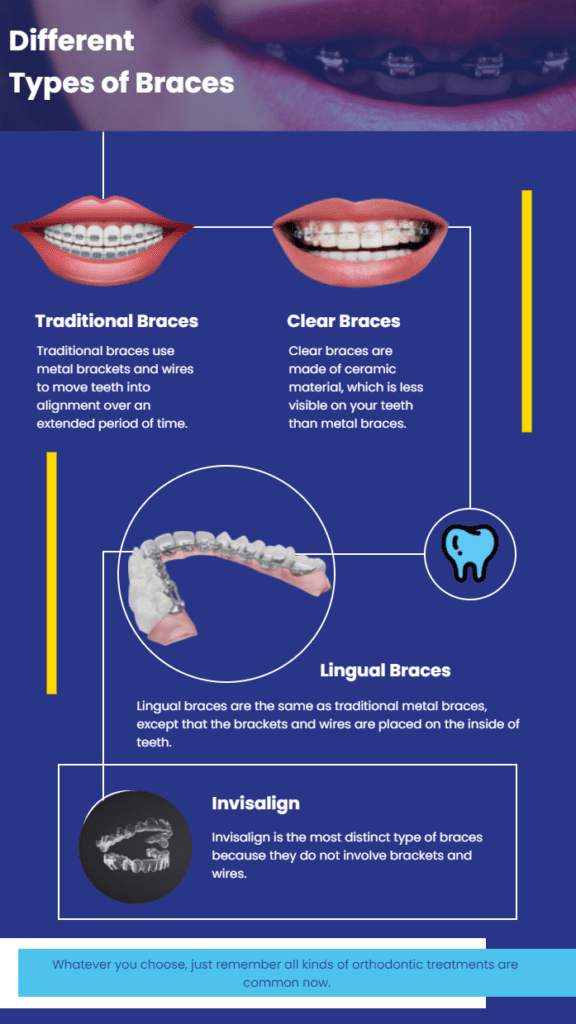How Cumming Orthodontics Addresses Common Braces and Invisalign Worries
How Cumming Orthodontics Addresses Common Braces and Invisalign Worries
Blog Article
Comprehensive Guide to Orthodontics Treatments for Fixing Oral Misalignments
Comprehending the complexities of each treatment, including their systems, advantages, and prospective downsides, is vital in making notified choices regarding one's orthodontic therapy. As we navigate with the comprehensive overview to orthodontic treatments for fixing oral misalignments, the complex details of each technique will certainly unfold, dropping light on the course toward a harmonious and useful oral positioning.
Orthodontic Procedures Review

In addition to clear aligners and typical dental braces, orthodontists might also recommend other interventions like headwear, palatal expanders, or retainers to resolve specific positioning problems (cumming orthodontics). These treatments are customized to every individual's one-of-a-kind demands and might entail a mix of therapies to accomplish the preferred outcomes. Routine modifications and tracking are vital components of orthodontic therapy to make certain progress gets on track and to make any kind of essential alterations along the way. By undergoing orthodontic procedures, people can not just attain a straighter grin yet additionally boost their general oral health and function.
Traditional Dental Braces: Just How They Function
When considering orthodontic treatments for dental imbalances, traditional braces stand out as a time-tested method for correcting teeth positioning. Traditional braces consist of brackets, cords, and bands that function with each other to apply constant stress on the teeth, slowly moving them into the desired alignment.
One key facet of just how typical dental braces work is the process of bone remodeling. As pressure is related to the teeth with the braces, the bone surrounding the teeth is improved to sustain the brand-new tooth settings. This renovation is vital for the long-term security of the dealt with positioning. Clients will require routine adjustments at the orthodontist's workplace to make sure the dental braces remain to use the right pressure for effective teeth activity.
Unseen Aligners: Disadvantages and pros
Undetectable aligners use a practical and discreet choice to standard braces for correcting oral imbalances. These clear, custom-made trays are practically invisible when worn, making them an attractive option for people looking for an extra cosmetically pleasing orthodontic treatment. Among the primary advantages of invisible aligners is their removability, permitting easier maintenance of dental health compared to conventional dental braces. Clients can get rid of the aligners prior to eating or brushing their teeth, lowering the risk of food getting embeded the appliance and simplifying the cleansing process.

Surgical Orthodontic Options
Surgical treatments in orthodontics existing sensible choices for attending to intricate oral misalignments that might not be effectively solved with standard orthodontic therapies. While unseen aligners and traditional dental braces can fix many orthodontic issues, certain cases require medical intervention to achieve optimal results. Surgical orthodontic alternatives are normally recommended for serious malocclusions, significant jaw inconsistencies, and situations where the underlying bone framework needs alteration to achieve appropriate placement.
One common surgical orthodontic treatment is orthognathic surgery, which includes rearranging the jaws to correct functional problems such as problem speaking or chewing. This surgical treatment is often carried out in cooperation with an orthodontist that helps align the teeth before and after the treatment. Surgical orthodontics might additionally involve procedures to subject influenced teeth, get rid of excess gum tissue, or reshape the jawbone to produce a much more unified face account.
Before thinking about medical orthodontic alternatives, patients go through a detailed evaluation to determine the necessity and prospective advantages of such treatments. invisalign. While surgical treatment might appear overwhelming, it can significantly improve both the function and visual appeals of the smile in cases where traditional orthodontic therapies fail
Retainers and Post-Treatment Treatment

Post-treatment care entails following the orthodontist's instructions faithfully. This might include proper dental health practices, attending follow-up consultations, and using the retainers as prescribed. Failure to abide by post-treatment care instructions can cause regression, where the teeth gradually relocate back towards their original placements. Constant retainer wear, good dental hygiene, and normal dental check-ups are essential for keeping the results attained with orthodontic surgery and ensuring the lasting stability of the corrected oral alignment.
Conclusion
In verdict, orthodontic procedures provide numerous options for correcting dental imbalances. Traditional dental braces make use of metal brackets and cords to shift teeth into correct alignment. Unnoticeable aligners give a more discreet option yet might not appropriate for all situations. Surgical orthodontic alternatives are available for much more extreme imbalances. Retainers are typically utilized post-treatment to keep the new positioning. On the whole, orthodontic treatments can effectively enhance dental health and wellness and visual appearance.
As we browse via the extensive overview to orthodontic treatments for dealing with dental misalignments, the elaborate details of each method will unravel, losing light on the course towards a functional and harmonious oral placement. - invisalign
One of the most typical orthodontic treatments is the usage of dental braces, which consist of metal braces and cords that use gentle stress to progressively move teeth into the desired placement.When taking into consideration orthodontic treatments for dental imbalances, standard braces stand out as a time-tested approach for remedying teeth positioning. Additionally, invisible aligners might not be appropriate for complex orthodontic concerns that call for even more substantial teeth motion, as they are generally advised for light to moderate instances. Retainers are tailor-made orthodontic devices made to hold teeth in their remedied positions after the conclusion of orthodontic treatment.
Report this page